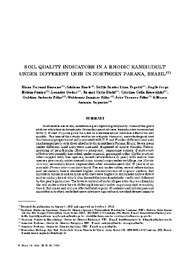Soil quality indicators in a rhodic kandiudult under different uses in northern Parana, Brazil.
Soil quality indicators in a rhodic kandiudult under different uses in northern Parana, Brazil.
Autoria: KUWANO, B. H.; KNOB, A.; FAGOTTI, D. S. L.; MELEM JUNIOR, N. J.; GODOY, L.; DIEHL, R. C.; KRAWULSKI, C. C.; ANDRADE FILHO, G.; ZANGARO FILHO, W.; TAVARES FILHO, J.; NOGUEIRA, M. A.
Resumo: Sustainable use of soil, maintaining or improving its quality, is one of the goals of diversification in farmlands. From this point of view, bioindicators associated with C, N and P cycling can be used in assessments of land-use effects on soil quality. The aim of this study was to investigate chemical, microbiological and biochemical properties of soil associated with C, N and P under different land uses in a farm property with diversified activity in northern Parana, Brazil. Seven areas under different land uses were assessed: fragment of native Atlantic Forest; growing of peach-palm (Bactrys gasipaes); sugarcane ratoon (Saccharum officinarum) recently harvested, under renewal; growing of coffee (Coffea arabica) intercropped with tree species; recent reforestation (1 year) with native tree species, previously under annual crops; annual crops under no-tillage, rye (Cecale cereale); secondary forest, regenerated after abandonment (for 20 years) of an avocado (Persea americana) orchard. The soil under coffee, recent reforestation and secondary forest showed higher concentrations of organic carbon, but microbial biomass and enzyme activities were higher in soils under native forest and secondary forest, which also showed the lowest metabolic coefficient, followed by the peach-palm area. The lowest content of water-dispersible clay was found in the soil under native forest, differing from soils under sugarcane and secondary forest. Soil cover and soil use affected total organic C contents and soil enzyme and microbial activities, such that more intensive agricultural uses had deeper impacts on the indicators assessed. Calculation of the mean soil quality index showed that the secondary forest was closest to the fragment of native forest, followed by the peach-palm area, coffee-growing area, annual crop area, the area of recent reforestation and the sugarcane ratoon area.
Ano de publicação: 2014
Tipo de publicação: Artigo de periódico
Unidade: Embrapa Amapa
Observações
1 - Por padrão são exibidas publicações dos últimos 20 anos. Para encontrar publicações mais antigas, configure o filtro ano de publicação, colocando o ano a partir do qual você deseja encontrar publicações. O filtro está na coluna da esquerda na busca acima.
2 - Para ler algumas publicações da Embrapa (apenas as que estão em formato ePub), é necessário ter, no celular ou computador, um desses softwares gratuitos. Sistemas Android: Google Play Livros; IOS: iBooks; Windows e Linux: software Calibre.
Acesse outras publicações
Acesse a Base de Dados da Pesquisa Agropecuária (BDPA) para consultar o acervo completo das bibliotecas da Embrapa.

